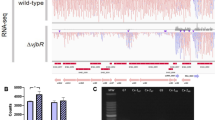Abstract
For lysogenization of Escherichia coli cells by bacteriophage λ, functions of three λ genes called c are necessary. The cI gene codes for a repressor that blocks activities of lytic promoters. However, early after infection, expression of cI is dependent on the function of the cII gene, coding for a specific transcriptional activator. The cII protein is unstable in E. coli cells due to FtsH-mediated proteolysis. The cIII gene product is an inhibitor of the FtsH protease. Here we demonstrate that cIII may have another function apart from inhibition of cII degradation. We found that overexpression of the cII gene results in impaired lysogenization by phage λ, however simultaneous overexpression of the cIII gene abolished this negative effect on lysogenization. Analysis of cII-mediated transcriptional activation of certain promoters at different levels of cII and cIII proteins in cells confirmed that observed effects cannot be explained assuming that the only role of cIII is inhibition of FtsH-mediated degradation of cII. We propose that cIII has an additional role apart from its well-known function in indirect stabilization of cII. Apparently, cIII influences not only cII level but also activity of this transcriptional stimulator, especially at its high concentrations.
Similar content being viewed by others
References
Taylor K. and Węgrzyn G., in Busby S.J.W., Thomas, C.M., and Brown N.L. (eds), Molecular Microbiology. Springer Verlag, Berlin-Heidelberg, 1998, pp. 81-97.
Ptashne M., A Genetic Switch: Phage λ and Higher Organisms. Cell Press and Blackwell Scientific Publications, Cambridge, MA.
Thomas R., BioEssays 15, 285-289, 1993.
McAdams H.H. and Shapiro L.L., Science 269, 650-656, 1995.
Gottesman M., J Mol Biol 293, 177-180, 1999.
Hoyt M.A., Knight D.M., Das A., Miller H.I., and Echols H., Cell 31, 565-573, 1982.
Rattray A., Altuvia S., Mahajna J., Oppenheim A.B., and Gottesman M., J Bacteriol 159, 238-242, 1984.
Herman C., Thevenet D., D'Ari R., and Bouloc P., J Bacteriol 179, 358-363, 1997.
Thomas M.S. and Glass R.E., Mol Microbiol 5, 2719-2725, 1991.
Goldberg A.R. and Howe M., Virology 38, 200-202, 1969.
Obuchowski M., Shotland Y., Koby S., Giladi H., Gabig M., Węgrzyn G., and Oppenheim A.B., J Bacteriol 179, 5987-5991, 1997.
Węgrzyn G., Glass R.E., and Thomas M.S., Gene 122, 1-7, 1992.
Obuchowski M., Giladi H., Koby S., Szalewska-Pałasz A., Węgrzyn A., Oppenheim A.B., Thomas M.S., and Węgrzyn G., Mol Gen Genet 254, 304-311, 1997.
Gabig M., Obuchowski M., Ciesielska A., Latała B., Węgrzyn A., Thomas M.S., and Węgrzyn G., Acta Biochim Pol 45, 271-280, 1998.
Obuchowski M., Węgrzyn A., Szalewska-Pałasz A., Thomas M.S., and Węgrzyn G., Mol Microbiol 23, 211-222, 1997.
Arber W., Enquist L., Hohn B., Murray N.E., and Murray K., in Hendrix R.W., Roberts J.W., Stahl F.W., and Weisberg R.A. (eds), Lambda II, Cold Spring Harbor Laboratory Press, Cold Spring Harbor, NY, 1982, pp. 433-466.
Miller J.H., Experiments in Molecular Genetics, Cold Spring Harbor Laboratory Press, Cold Spring Harbor, NY, 1972.
Hammer K., Jensen K.F., Poulsen P., Oppenheim A.B., and Gottesman M., J Bacteriol 169, 5289-5297, 1987.
Gabig M., Obuchowski M., Śrutkowska S., and Węgrzyn G., Mol Gen Genet 258, 494-502, 1998.
Author information
Authors and Affiliations
Rights and permissions
About this article
Cite this article
Latała, B., Obuchowski, M. & Wegrzyn, G. Bacteriophage λ cIII Gene Product has an Additional Function Apart from Inhibition of cII Degradation. Virus Genes 22, 127–132 (2001). https://doi.org/10.1023/A:1008146709982
Issue Date:
DOI: https://doi.org/10.1023/A:1008146709982




